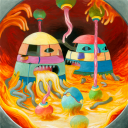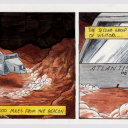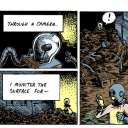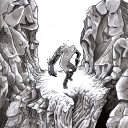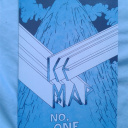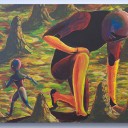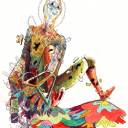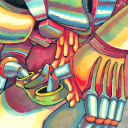Having always created drawings in the comic direction, artist Curtis Tinsley takes a moment to tell us about his recent art, upcoming projects and concepts beyond his vivid galactic work.
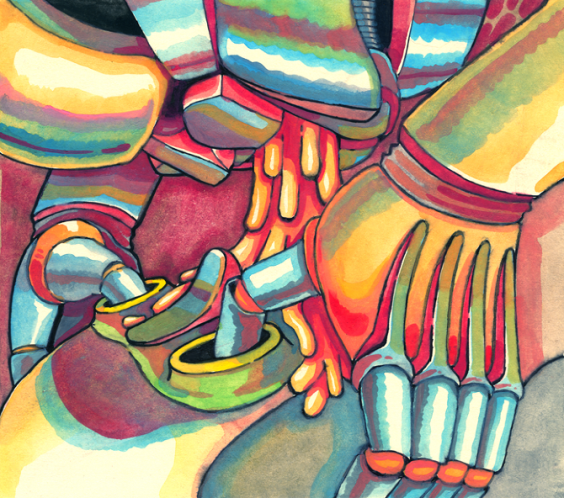
[alert style=”white”] Curtis Tinsley // Saint Louis, USA // http://www.curtistinsley.com [/alert]
How long have you been drawing pictures? Do you remember the first thing you ever drew?
I’ve been completely enthralled by drawing as far back as I can remember. I can’t recall what came first, but the earliest drawings were of stuff like the Ninja Turtles, Megaman & Marvel super heroes.
I have this memory of my dad teaching me to draw batman, and then redrawing it a million times until it looked better than his. This is all I’ve ever really wanted to do.
In what ways has your work changed since that early drawing? How has it stayed the same?
After highschool I made the biggest leap, and decided to quit drawing with such a heavy anime influence. Back then I was really into Akira & Dragon Ball, and I let that style infiltrate my drawings a little too much. When I realized my work was just bad emulations of that stuff, I wanted to change it drastically. I still see bits of it in my current work, but I’m over it. Robots age well though, and I’ve drawn quite a bit of them.
What keeps you motivated, productive or working on new material?
Reading a lot of other comics, mostly. Looking at other people’s art is the most motivating thing for me.
Internally, I just have a lot of ideas floating around and want to see them finished. I have a bad habit of leaving cliff hangers in comics that take a while to resurface, but I’m more productive than ever these days. I’m positive there will be a steady flow of new stuff to look at, and some resolution for the comics I have started throughout next year.
Tell us how you decide the colors in your illustrations and paintings. Is there a secret ritual to get it right?
I was actually pretty bad at coloring for a while, and I think I still have ways to go. I learned a lot through digital art, after I bought a tablet. Having infinite layers is really handy for attempting to color something repeatedly until you get it right.
For now, I’m really into conjuring up vivid characters with bright, identifiable color schemes. I kind of refuse to use black and sometimes gravitate towards cool shadows too much, but I try and give vibrant light sources and more natural colors for the surroundings. The short answer is that there are a lot of layers of paint to get it right.
Is there a concept behind the recent art you created for the new Spelling Bee album? That environment seems biological… Is it safe or toxic?
Well, it would be a safe spot to be in, if that chamber wasn’t open. The Caterwaul cover is about three strange giants exposing the inside of some futuristic city’s power source.
The back cover is really the first part, and it shows the three creatures perched around spots surrounding the reactor, as it has just been opened. What starts as a bright yellow light is intensified on the front cover where you see the inside, mid-formation. Two dome-like, segmented heads are spinning around while a steady flow of plasma churns from their mouths and starts filling the place up. The pods and red columns are evidence of a dense web of muscle that forms sometime after the image you’re seeing. Joe Hess, Spelling Bee’s drummer, asked me for something bright and strange, and that’s what I came up with.
Give some details about some of your recent projects; like Sand Level, Ice Map No. One and Cahokia Truth.
Sand Level is my free-handout comic. Each one runs 6 pages, and it’s slowly telling the story of an important prince, sabotaged by an unnamed party. As far as I have written, the prince will wander a dessert planet for a while until he starts finding more and more clues pertaining to a pretty large population living right under his nose.
For Ice Map, I really just want to explain two things. One, this book is going to come out annually in four parts. And two, while the comic has absolutely nothing to do with ice or maps and features two characters that look like they’re from different time periods, I promise by the end of the second installment you’ll get the connection between the two stories.
Cahokia Truth is nearest to my heart. I have a couple of notebooks full of plot points and diagrams to keep everything in order. While it is in it’s early stages right now, I’m drawing this comic strip daily, so I don’t want to give away much of the story. Even when I can’t stand the work involved with drawing it so often, Cahokia Truth will continue updating frequently until completion. I’m expecting it to stretch on for quite a while. Currently, it’s about a large number of visitors who’ve arrived in a space ship called Atlantis 05. In six or so strips, I finally narrowed in on some main characters: Amorh & Cam, but I will spoil something and say that they won’t last very long. You’ll have to read it to find out if it’s by some terrible event or just another mega time jump.
You have recently released both printed and web comics. Do you prefer one more than the other or what does each medium mean for you?
I definitely prefer print, simply because you’re producing a physical product. The feeling of flipping through a book is way better than clicking on a screen. Web comics definitely have some amazing advantages though. Not only does nobody have to give you money to look at them, but it doesn’t cost anything to present them. The web is great for putting stuff out quickly to keep people reading.
What other sort of work have you done with local bands or in your collaborations?
Most of the work I do for local bands tends to be for experimental groups. I guess my strange art just fits nicely with that style. Occasionally I’ll get asked to do album covers or t-shirt designs. My favorite shirt I did was for Yowie, to raise money for their newest album. Apop put out a great 7″ by Egg Chef that even features two pages of my comic stuff. Also, I’ve been Spelling Bee’s inside man for a lot of shirts and album art, too. Joe used to write comic books with me in gradeschool, by the way.
Many of your characters have masks, appearance altering space gear or minimal robotic features. What do the themes of being disguised, hidden or artificial mean to you?
There’s nothing cooler to me than characters who are really reserved and mysterious, but posses some superior ability. Masks are an obsession of mine, because they hide such an important feature. By covering the facial features, it eliminates a lot of personality and the character’s are judged solely on their actions. I try and give my masked characters two identities: one that projects an ability or status, and a vulnerable side that is only exposed to those closest. When people finally see the mask come off, my intention is that they’ve been anxious to see what’s under it. I want you to like both versions of the same person for different reasons.
I can answer the question about space gear and robot features easily. Because they look awesome, and provide wonderful loopholes for fantastic situations.
I am really intrigued by the Vomit piece. Who are these characters and what sparked the aggression?
For practice, I set out to explore extreme closeups on robot facial features, and then just thought up a scenario that could happen in such a small frame. I wanted the one on bottom to have innocent looking features, and the one on top to look really menacing. The wide, round eyes worked out pretty well, making him look petrified by the whole situation. There is no real reason why..
What sort of advice would you give someone interested in creating comics?
Read anything and everything by Scott McCloud. His titles, Understanding Comics & “Making Comics, are essential reads for anyone even remotely interested in comics. Beyond that, I would say keep digging around the internet for new art, and learn from old comics. Find a bunch of artists who inspire you and draw a lot! Try different techniques and more specifically, work hard on things like pacing and balanced scene transitions.
When you are not making art, what might you be doing?
Playing guitar or zoning out. I’m in this half Saint Louis, half Chicago Band called Airglow, and we play shows occasionally, but I’m hunched over my drafting table most of the time, though.
Who or what inspires you the most recently?
Jesse Moynihan, and his webcomic Forming. It’s absolutely amazing and I work hard to avoid having similar elements in my work, because I love it so much. Along with him, I’m obsessed with a bunch of artists. Vincent Giard, Malachi Ward, Tom Herpich, Michael DeForge & James Jean to name a few. Also, I live with another artist who has been super inspiring named Jon Strode. He’s right on the cusp of putting together and releasing an awesome comic book.
Are you working on anything new or secret that you would like to share?
In my spare time, I’ve been working out the kinks in a 30 page one-shot. I plan on producing really polished, painted comic pages, in hopes of printing a high quality book. Beyond that, I’m in talks with one of St. Louis’s fine publications about doing producing some stuff, but that’s still in early stages right now.

